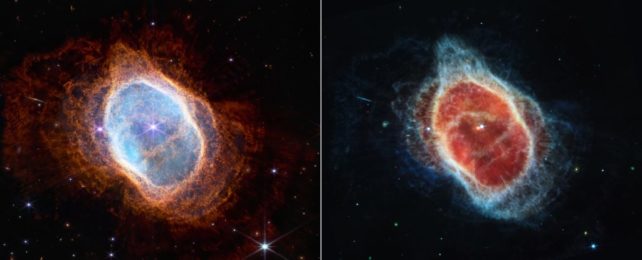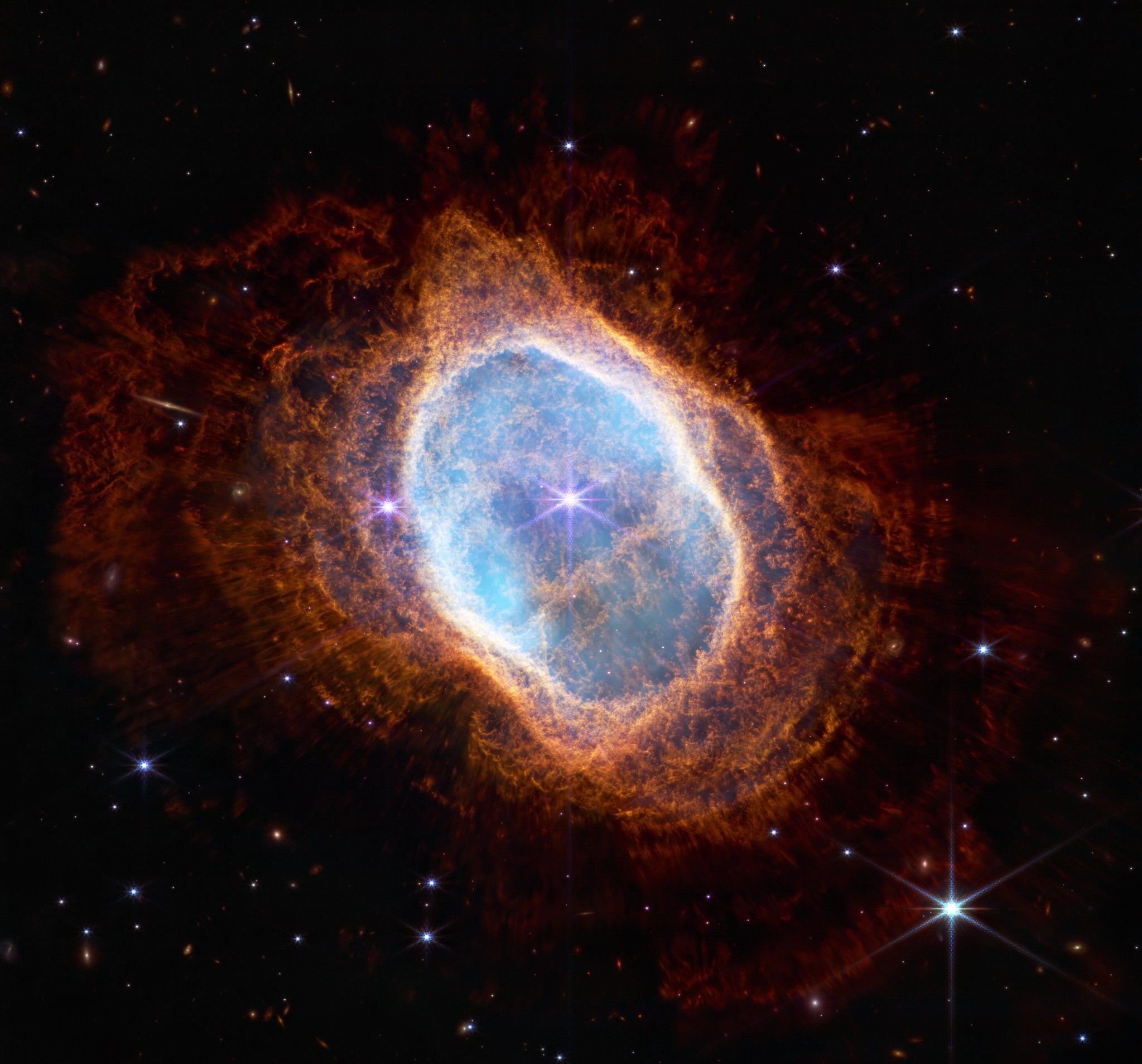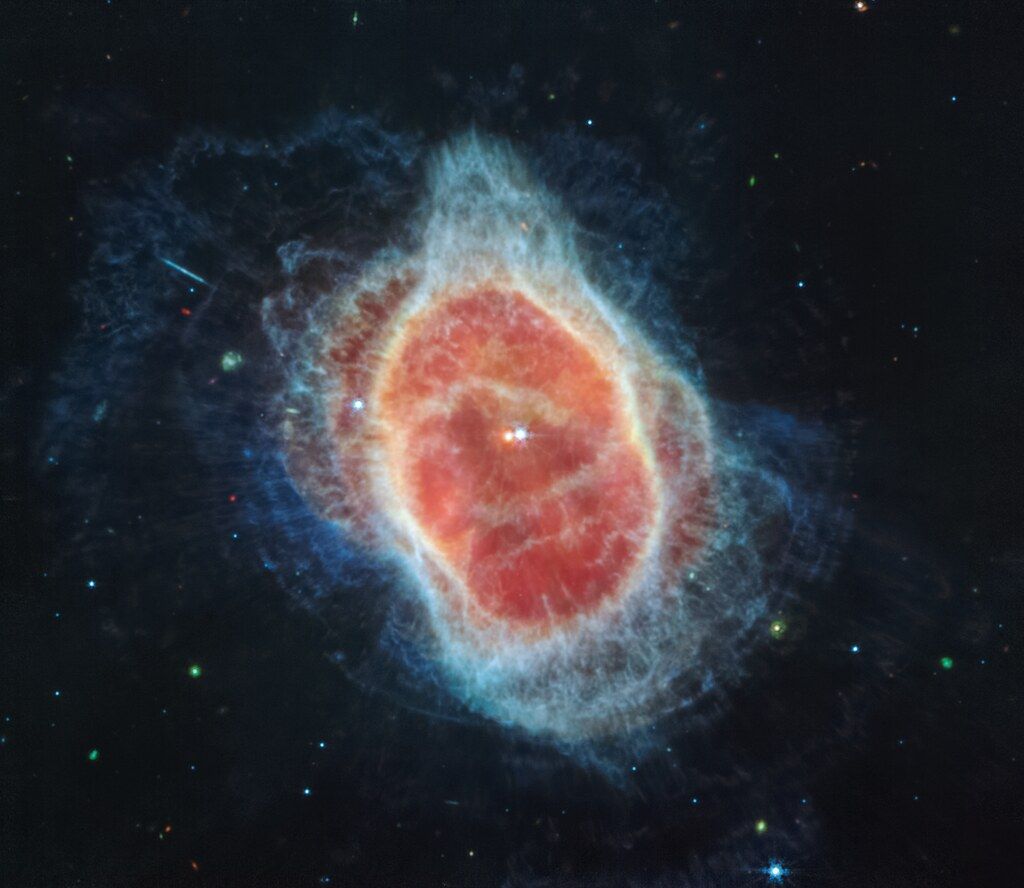Astronomers 'Surprised' by The Cause of The Southern Ring Nebula's Iconic Shape
 The Southern Ring Nebula as seen through JWST's NIRCam (left) and MIRI (right). (NASA, ESA, CSA, and STScI)
The Southern Ring Nebula as seen through JWST's NIRCam (left) and MIRI (right). (NASA, ESA, CSA, and STScI)The intricate whorls and curlicues of the Southern Ring Nebula – recently made famous for its place as one of the first objects imaged by JWST – are the product of at least four stars, new research has revealed.
Studying images from the new space telescope, an international team of astronomers has found previously unknown stars in the cloud of glowing gas and plasma.
The presence of these stars explains the structures still being carved out as the nebula expands, the product of the violent death of the single star at the nebula's center.
"We were surprised to find evidence of two or three companion stars that probably hastened its death as well as one more 'innocent bystander' star that got caught up in the interaction," explains astrophysicist Orsola De Marco of Macquarie University in Australia, who led the research.
Planetary nebulae like the Southern Ring Nebula form from the death of a star like the Sun. When the star starts to run out of the fuel needed for nuclear fusion in its core, it puffs up to hundreds of times bigger, expanding outwards into a red giant.
Eventually, the fuel is exhausted, and the star's outer material is ejected into space while the core collapses into a white dwarf. The ejected material continues to expand outwards and, ionized by the radiation from the white dwarf (which will continue to shine with residual heat for potentially trillions of years), shines with fluorescence.
This is the planetary nebula, so-named because, without interference by other objects, they tend to be quite spherical, resembling a planet.

But if there's something else near the star – and there often is, since many stars are in multiple-star systems gravitationally bound together – magnificent structures can form in the nebula as it travels through space.
The Southern Ring Nebula, officially named NGC 3132 and located some 2,460 light-years away, is the death shroud of a star that was an estimated three times the mass of the Sun in life. Now, that star is a small, dense white dwarf, around half the mass of the Sun, packed into a sphere around the size of Earth.
It's also surrounded by a cloud of cool dust that makes it difficult to see. The JWST image released in July marked the clearest view of it ever obtained – the infrared and near-infrared wavelengths of light in which JWST views the Universe can penetrate dust more effectively than other wavelengths.
But there was a lot more to be found in the image.
"When we first saw the images, we knew we had to do something, we must investigate!" De Marco says. "The community came together, and from this one image of a randomly chosen nebula, we were able to discern much more precise structures than ever before."
There's a second star close to the center of the nebula. It, too, was already known, a binary companion to the white dwarf. This star is at an earlier stage of its life and is still on the main sequence, yet to commence the series of transformations that mark the end of its days.
Spiral structures creating arches around the center of the nebula are the product of the orbital dance of these two stars – the dead white dwarf and its living companion. But when the researchers conducted a three-dimensional reconstruction of the nebula, they found pairs of structures that form when objects such as stars and black holes spew jets of plasma from their poles.

This suggested that more stars are present in a convoluted stellar waltz.
"We first inferred the presence of a close companion because of the dusty disk around the central star, the further partner that created the arches, and the super far companion that you can see in the image," De Marco explains.
"Once we saw the jets, we knew there had to be another star or even two involved at the center, so we believe there are one or two very close companions, an additional one at middle distance and one very far away. If this is the case, there are four or even five objects involved in this messy death."
The new images also allowed the researchers to perform a new calculation of the white dwarf's temperature. It's burning at around 110,000 Kelvin (about 109,700 degrees Celsius, or 197,540 degrees Fahrenheit).
Planetary nebulae are relatively short-lived phenomena, only fluorescing for about 10,000 years before dissipating into interstellar space. So in one sense, we are very lucky to have caught this stage in the life cycle of the Southern Ring Nebula. The team's results are also important for studying this period in the life of a white dwarf and the interactions that can occur.
And interestingly, the discovery of several new stars gravitationally bound together has implications for gravitational wave astronomy. White dwarfs are on a continuum of dense objects; they have the lowest mass and the lowest density, followed by neutron stars and black holes.
It's possible that "messy" systems like the Southern Ring Nebula could, in the future, result in multiple successive collisions between dead stars, resulting in objects with masses that are impossible to form from a single star.
The researchers said that studying more such objects with JWST could help us better understand how they form and inform future observations.
The research has been published in Nature Astronomy.

ASTRONOMERS USE WEBB TELESCOPE
TO DETECT HIDDEN STARS IN THE
SOUTHERN RING NEBULA
Infrared data from the James Webb Space Telescope has revealed three previously-unknown stars in a prominent nebula
AN ENSEMBLE OF HIDDEN STARS are finally getting credit for the Southern Ring Nebula, thanks to new James Webb Space Telescope (JWST) data gathered in June.
The mesmerizing nebula, located between 2,000 and 2,500 light years away in the constellation Vela, famously appeared as one of JWST’s first science targets. And now, astronomers have learned it is the final product of not one, or two, but at least five stars. Most of the labor is from the dim red star at the center of this nebula and its newly-revealed companions. But, the vibrant bright-blue star at the center also offers new scientific opportunities, when it helped astronomers glean that the dim red star was about three times the size of the Sun before this nebula emerged.

Each of these images is a composite view of the Southern Ring Nebula. They combine data from two instruments on the James Webb Space Telescope: The Mid-Infrared Instrument (MIRI) and the Near-Infrared Camera (NIRCam). The image on the left “highlights the very hot gas that surrounds the central stars,” according to the telescope’s team. The image on the right “traces the star’s scattered outflows that have reached farther into the cosmos.”
“Including the previously known A-type visual companion, the progenitor of the NGC 3132 planetary nebula [the Southern Ring Nebula] must have been at least a stellar quartet,” a team of 69 astronomers wrote in a study published Thursday in the journal Nature Astronomy.
The red dying star is surrounded by some of its own former dust. Other stars then played with this material. “We think all that gas and dust we see thrown all over the place must have come from that one star, but it was tossed in very specific directions by the companion stars,” study author Joel Kastner states in a JWST announcement of the study.
According to JWST officials, the “opposing bumps” visible at the edges of the Southern Ring Nebula formed from two-sided jets, which came about as the red star interplayed with one or two smaller stars.
One launched the jets. Just as it was slowing down its activity, it added dust to the mix by shedding.
The other close companion stirred these jets. As a result of visiting the red star multiple times, it created “the wavy shapes we see today at the edges of the gas and dust,” JWST officials wrote.

Some of the gas and dust ejected into space as thin, straight lines (second box) and others took bent, curvy and thick paths (first box). These brightly-lit lines pierce the rings at the Southern Ring Nebula’s edges thanks to “holes” in the nebula, the JWST team wrote in an image description published December 8, 2022. “These ‘spokes’ appear to emanate from one or both of the central stars, marking where light streams through holes in the nebula. The holes are evidence of where the dimmer star that created this scene shot out material, creating open pathways for light to flow through.”
A third hidden star might have generated the system of rings that make the Southern Ring Nebula so unique. According to JWST officials, it “skew[ed] the evenly balanced ejections like spin art,” by agitating the jets of the first newly-revealed star. JWST officials described this star’s gas-and-dust meddling as “like a spatula running through batter in the same direction each time, generating the enormous set of rings in the outer reaches of the nebula.”
These stars are now hiding in the central glare, or merged with the dying red star.
THE BRIGHT WHITE-BLUE STAR
But the most visible star in the scene — the bright white-blue star — also revealed new information.
“New measurements of the A-type visual companion allow us to derive the value for the mass of the progenitor of a central star with excellent precision,” according to the study.
Before it sloughed dust and gas, the red star was once roughly 2.86 times the mass of the Sun. Now, it’s shrunk to just 60 percent of the Sun’s mass.
JWST officials described this finding as a “critical piece of evidence.” The initial mass helps astronomers reconstruct the scene and grasp what led to the nebula’s current shape.
MORE THAN JUST A PRETTY SIGHT
“These results serve as pathfinders for future JWST observations of planetary nebulae, providing unique insight into fundamental astrophysical processes including colliding winds and binary star interactions, with implications for supernovae and gravitational-wave systems,” the study authors wrote.
This study came from the JWST’s Early Release Observations. And there is more science to come from the telescope. Last month, the Space Telescope Science Institute put out a call for research proposals for JWST’s Cycle 2.
No comments:
Post a Comment